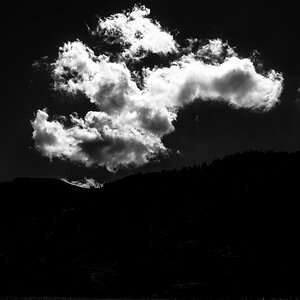smithdan
Been spending a lot of time on here!
- Joined
- Sep 1, 2012
- Messages
- 1,096
- Reaction score
- 2,491
- Location
- Southwest Alberta Canada.
- Can others edit my Photos
- Photos OK to edit
Not very many mid and better quality cameras using 126 cartridges hit the market. Probably the compact 35's featuring motor film advance and drop in - slam the door loading had a lot to do with it.
The folks at Canon had the Canomatic M 70, and as they rebadged some of their cameras under Bell & Howell, this one hit the shelves in the early 70's.

Bit big compared to some of the rangefinders of the era but size depended on it's ability to devour a 126 cassette. Film advance is powered, a selenium meter runs shutter speed/ aperture combinations (no user input unfortunately) and there is a rather unique mechanical focusing aid, a strange way to go but probably convincingly easier than fiddling with a rangefinder for the target consumer.

The internet has directions on how to do almost anything so reloading 126 with 35mm is no exception. The plastic cassettes are quite flimsy and most of the procedure has to be done in the dark. Light leakage wasn't as big a problem as I thought it might be.
I expected sharper images, have another B&H with that lens, but the inevitable mutilation of the cassette most likely positions the film slightly off the focal plane. Another wrinkle with this hack is getting the film to advance correctly without the correct indexing holes. Luckily, shooting one then another with the lens cap on spaced the frames out evenly at about 1/8" between them. Fooling the scanner wasn't as hard as I had expected as well.
So all loaded up and taped up out we went looking for something to waste time and film on. All on FP4, D76 1:1.





The folks at Canon had the Canomatic M 70, and as they rebadged some of their cameras under Bell & Howell, this one hit the shelves in the early 70's.
Bit big compared to some of the rangefinders of the era but size depended on it's ability to devour a 126 cassette. Film advance is powered, a selenium meter runs shutter speed/ aperture combinations (no user input unfortunately) and there is a rather unique mechanical focusing aid, a strange way to go but probably convincingly easier than fiddling with a rangefinder for the target consumer.
The internet has directions on how to do almost anything so reloading 126 with 35mm is no exception. The plastic cassettes are quite flimsy and most of the procedure has to be done in the dark. Light leakage wasn't as big a problem as I thought it might be.
I expected sharper images, have another B&H with that lens, but the inevitable mutilation of the cassette most likely positions the film slightly off the focal plane. Another wrinkle with this hack is getting the film to advance correctly without the correct indexing holes. Luckily, shooting one then another with the lens cap on spaced the frames out evenly at about 1/8" between them. Fooling the scanner wasn't as hard as I had expected as well.
So all loaded up and taped up out we went looking for something to waste time and film on. All on FP4, D76 1:1.




![[No title]](/data/xfmg/thumbnail/31/31033-d583468208439e9103b8a87a7eccb965.jpg?1619734580)







